How to Run a Sailboat Retrospective: A Step-by-Step Guide
How to Run a Sailboat Retrospective: A Step-by-Step Guide
Explainer video
Introduction
The power of the sailboat retrospective is in the way you visualize everything from the previous sprint. You can visualize the sprint goal on the template as your focus point.
Running the sailboat retrospective, you and your team are trying to find how to get the boat to smooth sailing. Searching for risks they'll face, seeing what is working, looking for things that are slowing them down, and making sure the sailboat is heading in the right direction.
The sailboat retrospective template is one of the top agile retrospectives you can use to improve your team!
The elements of the sailboat retrospective
The retrospective consists of five elements. The sailboat, the sail, the anchor, the rocks, and the island (the focus point of the retrospective).
It gives you, as the facilitator, the perfect starting point to communicate the exercise through metaphors.

The sailboat
The sailboat represents the entire team and their processes sailing to their goal. You can use the metaphor: "Is the sailboat heading in the right direction?"
The island
The island represents the sprint goal of your team's last sprint. This is where the team wants to go.
The sail
What is giving us wind in our sails to go to the island? What helps us move forward?
The team focuses on the good things that are happening and are helping them achieve their goals. What efforts move the team forward to their sprint goal?
The anchor
What is holding us back from going to the island?
Here the team focuses on the bad things that they are doing. They'll look for impediments and issues they've faced.
The rocks
What are the rocks we face when going to our island?
The rocks represent the potential risks they'll face. This part of the exercise helps them to be proactive about oncoming risks.
The benefits of the sailboat excercise
The sailboat retrospective is a great tool to see if the team is doing the right things to hit their goal. They identify risks, see what is holding them back and get to know what is working.
It brings the team members on the same page and helps improve the team's success. It gives the scrum master valuable feedback that he or she can use to help the teams focus.
As with every retrospective, it helps the team apply continuous improvement in their workflow as described in the agile manifesto.
How to run the sailboat retrospective
Facilitating sailboat retrospectives is pretty straightforward. Every good retrospective has a chronological number of exercises. This format makes it easier for the facilitator and the agile team.
We are going over the sailboat retrospective template, and I'll give you some retrospective techniques where you and your team can focus when creating actionable items.
Set ground rules for the retrospective (+- 3 min)
During a retrospective, we take our team and ourselves under the microscope. This can be an uncomfortable experience for many of us. Therefore we need to set some ground rules with the team and create an atmosphere where people feel comfortable participating.
Good ground rules
- What is said in the retrospective stays between the participants
- It is encouraged to air dirty laundry and express opinions.
- Try to focus on organizational systems and process improvements.
- It is a blame-free environment
- Encourage participation from everyone
Introduce the sailboat exercise (+- 3 min)
When the ground rules are set, we can introduce our sailboat and what we'll do during the retrospective.
Here's an example introduction:
Team, today we are doing the sailboat retrospective. We, the team are on the sailboat. We're trying to go to the island which represents our last sprint goal. [Insert sprint goal].
During our trip we've been lucky to have great wind in our sails. But we noticed that our anchor has been dragging along and slowing us down. We're going to try to raise our anchor a bit higher so we can move faster to our island.
Like every sail trip, we'll face some rock along the way. This is risky business. We'll try to inspect what is risks we'll likely face so we can improve our sailboat and go smooth sailing.

The sail (+- 10 min)
The first step the team members take is the sail. Here we are going over what is working for the team. This exercise helps the team loosen up for the harder parts of the sailboat retrospective.
One retrospective technique we'll use throughout is working together alone. This means the exercises are done in silence alone. After a set period, we'll present our ideas and choose one to continue with.
Before flying straight into the sail exercise, introduce it to your team.
Here's an example introduction:
The first part of the sailboat retrospective is the sail. We will look what helps us move forward in our journey to our island. [Insert sprint goal]
We are going to all work in silence for [Insert forseen time] when we are writing down our thoughts. Write every thought down on individual sticky notes. Afterwards we'll present our sticky notes to each other.
Are there any questions?
When time passed that the team worked alone, we'll present the sticky notes to each other and put them on the sail. Keep the presentation simple, don't go deeper into the topic that is written down. Just saying out loud what is written on the sticky note is enough.
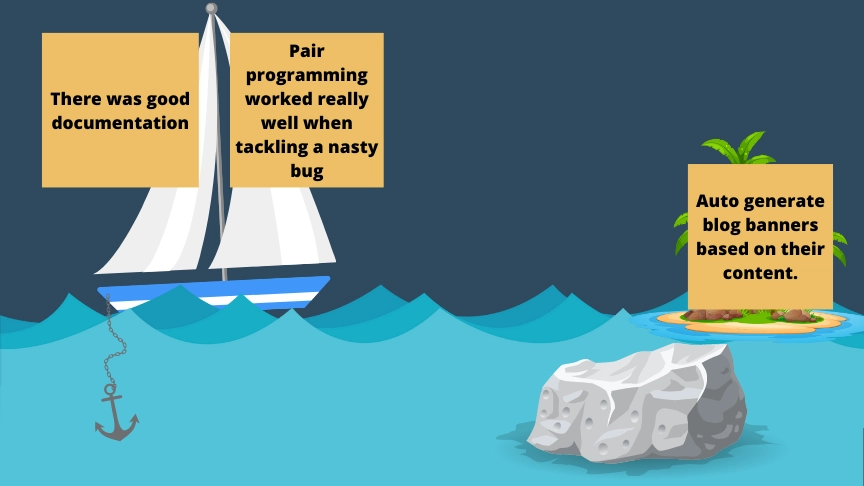
The anchor (+- 10 min)
The second step in the sailboat retrospective is the anchor. Here the team will focus on what is holding them back from reaching their target. Here we are trying to find where our process is lacking.
Here we'll use the same retrospective technique working together alone.
You can use the following template when introducing the anchor to your team.
Now that we know what helps gives us wind in the sails and helps us move forward. We'll now focus on our anchor. What is holding us back for moving forward towards [Insert sprint goal].
We are going to work again in silence alone for [Insert forseen time]. Afterwards we are not going to present the items to each other. We're just going to stick them on the lower side of the sailboat.
Are there any questions?
When the time has passed, let the team put the sticky notes on the bottom side of the sailboat.
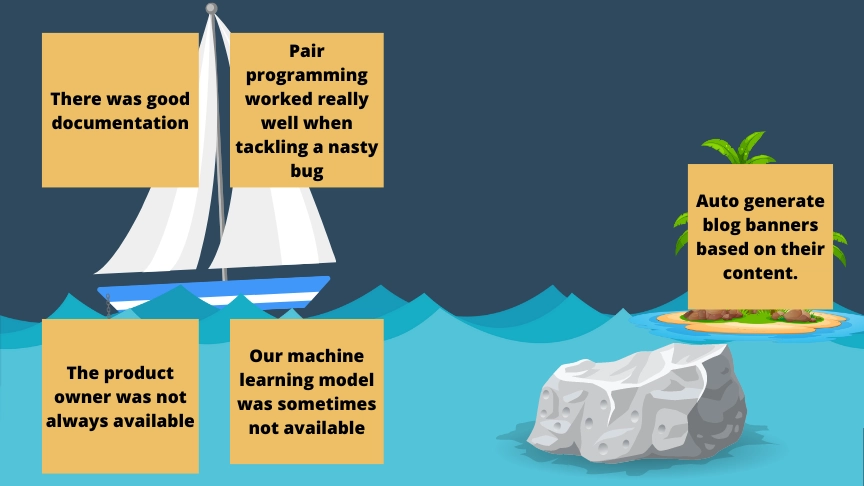
The rocks (+-10 min)
The third step in the retrospective meeting is the rocks. What rocks lie ahead of the team? After this exercise, we'll have identified risks we can be proactive about.
Again, we're working together alone. Afterward, we can stick our sticky notes on the rocks below our boat.
Here's an example introduction to the rocks:
Now that you've written down our anchors for our team, we're going to look ahead and see what risks we face for reaching [Insert sprint goal].
Again, we're woriking in silence for [Insert forseen time]. Afterward, we'll stick our sticky notes on the rocks.
Are there any questions?
When the time has passed, let the team put the sticky notes on the rocks.
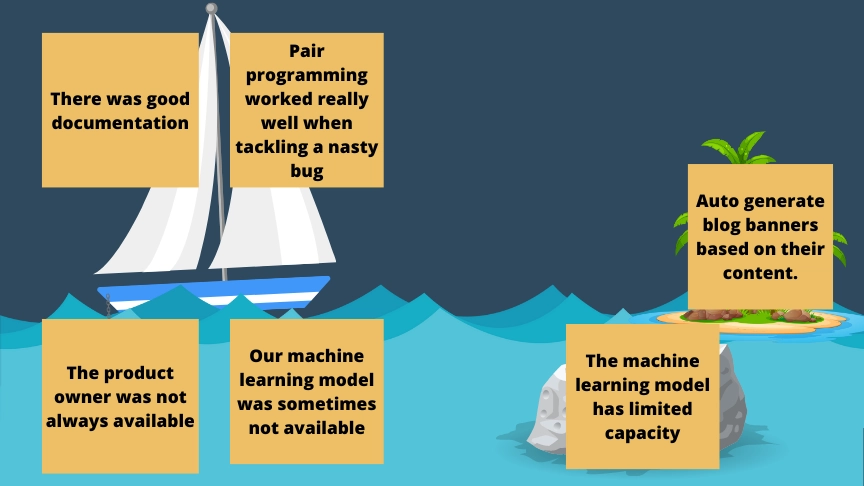
Vote! (+- 10 min)
We've captured a lot of insights from our team. But where do we need to put our focus? This is where we're going to vote.
There are multiple ways to vote for a focus point with your team. Here we are going to use dot-voting.
Give each team member ten votes they can use to vote on the sticky notes. They can vote on their own post-its and vote multiple times on one post-it. There are no rules.
While the team is voting, they can rearrange the post-its to make groups of related items.
Here is an example introduction to the voting part of the retrospective:
Now that we've capture all of our insights it is time to choose where we want to focus on as a team. We'll do this with our voting dots. You can vote on your own items and vote on multiple times on one item.
While we are looking over our insights, rearrange the items to group them toghether if they are related.
Are there any questions?
After time has passed, take the item with the most votes and put them to the side of the sailboat. Continue this step until you've created a top 3.
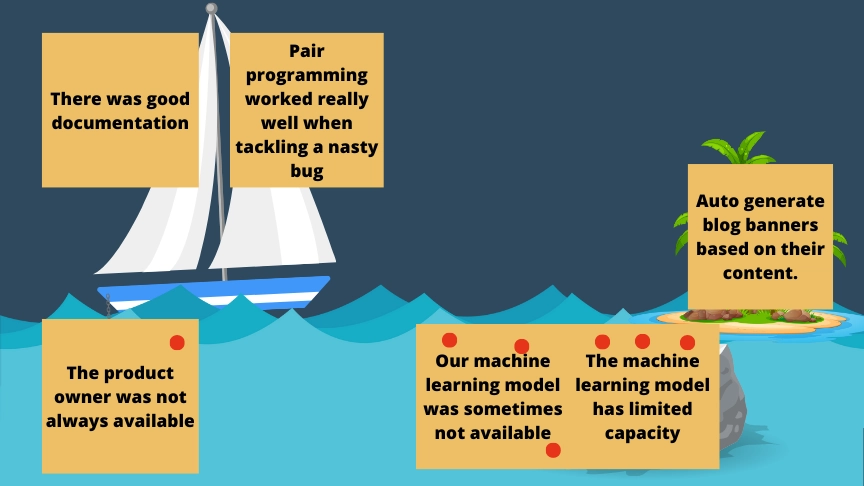
Brainstorming session ( +- 15 min)
We now know where the team wants to focus its efforts toward improving its processes. Now it's time to brainstorm ideas to improve future sprints.
We take the most voted issue and rephrase it to an opportunity question. We use the "How Might We" structure to create an opportunity for our anchor or risk that has been chosen.
Take the "How Might We" question you've created and put it on the top of another whiteboard or flipchart.
While we are brainstorming, everyone should work in silence again.
Here is how I would introduce the brainstorming session:
It is clear for us as a team where we want to put our efforts to improve our processes.
We are going to brainstorm on [Insert "How Might We" question].
You get [Insert forseen brainstorm time] to generate ideas that we can do in the next sprint to resolve [Insert problem statement]. You are working in silence again.
When the timer goes off, the team must select the best ideas. Here you can give them five votes to vote on the best ideas.
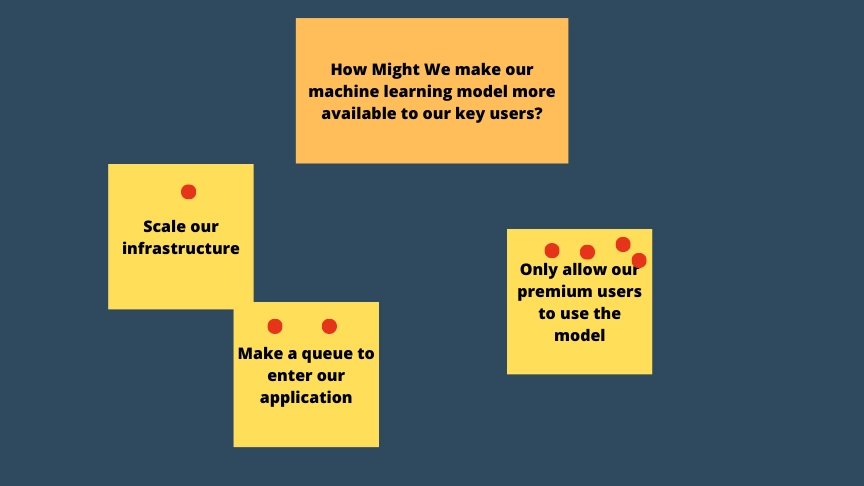
Create actionable items (+- 10 min)
The team voted on the best idea they've found. Now it is time to take action! An idea is great, but execution is needed to improve their current process.
For an agile team, this could mean updating their definition of done. Most of the time, you'll define an experiment you'll run with the team.
- When writing an experiment, consider the following questions.
- How long will this experiment run?
- Who is going to conduct this experiment?
- What is the expected outcome of this experiment?
- When are we going to reflect on this experiment?
You can write your experiment in the following format:
What? Only allow our premium users to use the model.
Who? Team Zebra
When? Next sprint
Expected outcome? Our premium users use the machine learning model more.
Reflection date? 20/04/2023
Conclusion
The sailboat retrospective is a great tool to create team alignment for improving the team processes. The metaphorical way helps the facilitator and the team in the process to identify areas where they can improve, what is holding them back, and the risks they'll face.

